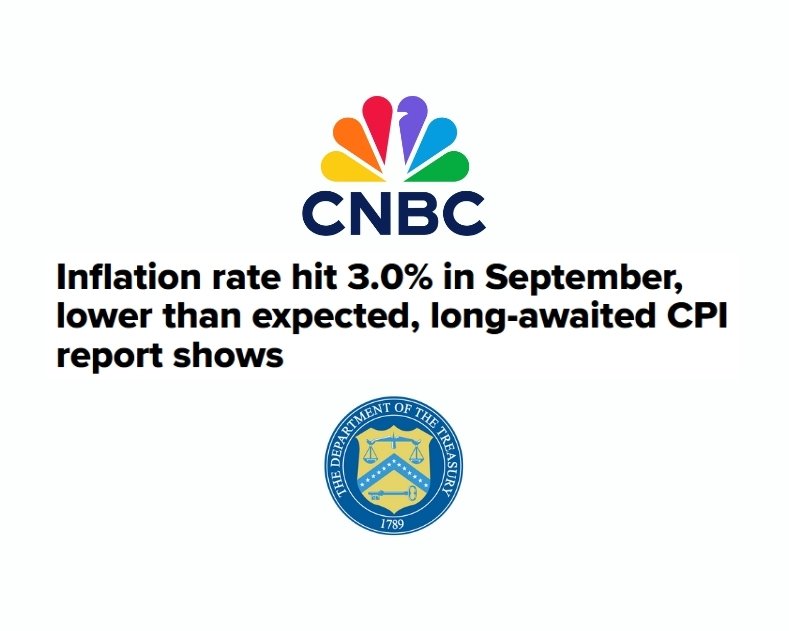

In September, the costs consumers incur for various goods and services increased less than anticipated, as per a Bureau of Labor Statistics report released on Friday, keeping the possibility open for another interest rate cut in the upcoming week.
The consumer price index posted a 0.3% rise for the month, resulting in an annual inflation rate of 3%. Economists polled by Dow Jones were expecting figures of 0.4% and 3.1%, respectively. The yearly rate indicated a slight 0.1 percentage point rise from August.
When excluding food and energy, the core CPI revealed a 0.2% monthly increase and an annual rate also holding at 3%, compared to predictions of 0.3% and 3.1%. The core CPI had shown monthly gains of 0.3% in both July and August.
This CPI figure stands as the sole official economic data permitted for release amid the government shutdown.
“Today’s CPI number served as a refreshing drink for investors amidst the drought of government data since the shutdown commenced on October 1,” stated John Kerschner, global head of securitized products at Janus Henderson. “Investors found it favorable. Inflation was milder than expected, leading to a subdued rally in the bond market, and confirming that the Fed is likely to lower rates in next week’s Open Market Committee meeting.”
Gasoline prices surged by 4.1%, marking the most significant factor in a report otherwise indicating minimal inflationary pressures. Food prices increased by 0.2%. Overall, commodity prices saw a rise of 0.5%. Annually, energy costs rose by 2.8% and food prices climbed by 3.1%.
Within the food index, prices for meat, poultry, fish, and eggs spiked by 5.2% over the last year, whereas nonalcoholic beverages increased by 5.3%. In energy, while electricity prices rose by 5.1% and natural gas by 11.7% over the past year, gasoline prices actually decreased by 0.5% during this timeframe.
Costs for shelter, which make up approximately one-third of the CPI’s weighting, increased only 0.2% and were up 3.6% compared to a year ago. Services excluding shelter also rose by 0.2%.
New vehicle prices recorded a 0.8% increase, while used car and truck prices declined by 0.4%.
Following the release, stock market futures increased, while Treasury yields were marginally negative.
“Inflation may not be decreasing but it’s no longer surprising on the upside,” commented David Russell, global head of market strategy at TradeStation.
The report provides insights into the current state of the U.S. economy while all other data releases remain on hold. There were only limited repercussions from President Donald Trump’s tariffs, although their full effects have likely not yet permeated the economy.
Core goods prices recorded just a 0.2% monthly gain. Insights from the CPI report, paired with tariff-induced Customs revenue, signify a “realized” tariff rate of merely 10%, according to James Knightley, chief international economist at ING.
Signs of “a notable substitution effect are already emerging – U.S. companies opting for sourcing from countries with lower tariffs, affecting the import composition,” Knightley noted.
“The outcome is that businesses can better handle these more modest cost increases than anticipated, resulting in a less pronounced impact on inflation than previously forecasted,” he stated. “In the long run, we predict that the realized tariff rate will climb and goods prices will face more substantial impacts, but we maintain that tariffs will lead to a one-off adjustment in prices rather than ongoing inflation.”
Final report prior to the Fed
The BLS published this data specifically as the Social Security Administration utilizes it as a reference for cost-of-living adjustments (COLAs) in benefit payments. Otherwise, the federal government has halted all data collection and releases until the fiscal deadlock in Washington is resolved. The CPI report was initially slated for release on October 15.
Apart from serving as a guide for COLAs, the CPI report represents the last significant data point the Federal Reserve will consider before making its interest rate decision next week. The Fed targets a 2% inflation rate. The headline measure last fell below this threshold in February 2021.
“This report will undoubtedly keep the Fed aligned with its plan to lower rates,” remarked Art Hogan, chief market strategist at B. Riley Wealth. “The Fed has been very clear about its focus on the softening labor data and will continue to uphold its full employment mandate, despite core CPI being considerably above its 2% goal.”
Markets are nearly unanimously predicting that the central bank will reduce its benchmark overnight borrowing rate by a quarter percentage point from the current target range of 4%-4.25%. Traders are also foreseeing another cut in December.
However, the future trajectory remains much less certain.
Concerns linger that Trump’s tariffs might trigger another wave of troublesome inflation. Meanwhile, Fed policymakers are apprehensive that a decline in hiring this year could escalate, despite low levels of layoffs.
Tariff-affected apparel prices increased by 0.7% in September, while durable goods also rose by 0.3%.
Fed Chair Jerome Powell and his colleagues have conveyed a generally cautious approach towards the speed of rate cuts as they balance the inflation threat against fragility in the labor market. On his part, Trump insists that inflation is no longer an issue and that the Fed should be implementing aggressive cuts.

